Activity in the Photodegradation of 4-Nitrophenol of a Zn,Al Hydrotalcite-Like Solid and the Derived Alumina-Supported ZnO
Abstract
1. Introduction
2. Results and Discussion
2.1. Characterization of the Samples
2.2. Degradation Studies
3. Materials and Methods
4. Conclusions
Supplementary Materials
Author Contributions
Funding
Conflicts of Interest
References
- Abderrazek, K.; Najoua, F.S.; Srasra, S. Synthesis and characterization of [Zn–Al] LDH: Study of the effect of calcination on the photocatalytic activity. Appl. Clay Sci. 2016, 119, 229–235. [Google Scholar] [CrossRef]
- Barhoum, A.; Melcher, J.; Van Assche, G.; Rahier, H.; Bechelany, M.; Fleisch, M.; Bahnemann, D. Synthesis, growth mechanism, and photocatalytic activity of Zinc oxide nanostructures: Porous microparticles versus nonporous nanoparticles. J. Mater. Sci. 2017, 52, 2746–2762. [Google Scholar] [CrossRef]
- Zhang, Z.; Hua, Z.; Lang, J.; Song, Y.; Zhang, Q.; Han, Q.; Fan, H.; Gao, M.; Li, X.N.; Yang, J. Eco-friendly nanostructured Zn–Al layered doublehydroxide photocatalysts with enhancedphotocatalytic activity. Cryst. Eng. Commun. 2019, 21, 4607–4619. [Google Scholar] [CrossRef]
- Basile, F.; Benito, P.; Fornasari, G.; Rosetti, V.; Scavetta, E.; Tonelli, D.; Vaccari, A. Electrochemical synthesis of novel structured catalysts for H2 production. Appl. Catal. B Environ. 2009, 91, 563–572. [Google Scholar] [CrossRef]
- Chai, R.; Li, Y.; Zhang, Q.; Fan, S.; Zhang, Z.; Chen, P.; Zhao, G.; Liu, Y.; Lu, Y. Foam-Structured NiO-MgO-Al2O3 Nanocomposites Derived from NiMgAl Layered Double Hydroxides In Situ Grown onto Nickel Foam: A Promising Catalyst for High-Throughput Catalytic Oxymethane Reforming. Chem. Catal. Chem. 2017, 9, 268–272. [Google Scholar]
- Chai, R.; Fan, S.; Zhang, Z.; Chen, P.; Zhao, G.; Liu, Y.; Lu, Y. Free-Standing NiO-MgO-Al2O3 Nanosheets Derived from Layered Double Hydroxides Grown onto FeCrAl-Fiber as Structured Catalysts for Dry Reforming of Methane. ACS Sustain. Chem. Eng. 2017, 5, 4517–4522. [Google Scholar] [CrossRef]
- Chai, R.; Zhang, Z.; Chen, P.; Zhao, G.; Liu, Y.; Lu, Y. Ni-foam-structured NiO-MOx-Al2O3 (M = Ce or Mg) nanocomposite catalyst for high throughput catalytic partial oxidation of methane to syngas. Microporous Mesoporous Mater. 2017, 253, 123–128. [Google Scholar] [CrossRef]
- Rives, V. (Ed.) Layered Double Hydroxides: Present and Future; Nova Science Publishers: New York, NY, USA, 2001. [Google Scholar]
- Trujillano, R.; González-García, I.; Morato, A.; Rives, V. Controlling the Synthesis Conditions for Tuning the Properties of Hydrotalcite-Like Materials at the Nano Scale. ChemEngineering 2018, 2, 31. [Google Scholar] [CrossRef]
- Benito, P.; Guinea, I.; Labajos, F.M.; Rocha, J.; Rives, V. Microwave-hydrothermally aged Zn,Al hydrotalcite-like compounds: Influence of the composition and the irradiation conditions. Micropor. Mesopor. Mat. 2008, 110, 292–302. [Google Scholar] [CrossRef]
- Mishraa, G.; Dasha, B.; Pandey, S. Layered double hydroxides: A brief review from fundamentals to application as evolving biomaterials. Appl. Clay Sci. 2018, 153, 172–186. [Google Scholar] [CrossRef]
- Lee, K.M.; Lai, C.W.; Ngai, K.S.; Juan, J.C. Recent developments of zinc oxide based photocatalyst in water treatment technology: A review. Water Res. 2016, 88, 428–448. [Google Scholar] [CrossRef] [PubMed]
- Ong, C.B.; Ng, L.Y.; Abdul, W.M. A review of ZnO nanoparticles as solar photocatalysts: Synthesis, mechanisms and applications. Renew. Sustain. Energy Rev. 2018, 81, 536–551. [Google Scholar] [CrossRef]
- Serrà, A.; Zhang, Y.; Sepúlveda, B.; Gómez, E.; Nogués, J.; Michler, J.; Philippe, L. Highly active ZnO-based biomimetic fern-like microleaves for photocatalytic water decontamination using sunlight. Appl. Catal. B Environ. 2019, 248, 129–146. [Google Scholar] [CrossRef]
- He, X.; Wang, B.; Zhang, Q. Phenols removal from water by precursor preparation for MgAl layered double hydroxide: Isotherm, kinetic and mechanism. Mater. Chem. Phys. 2019, 221, 108–117. [Google Scholar] [CrossRef]
- Kwon, T.; Pinnavaia, T.J. Pillaring of a layered double hydroxide by polyoxometalate with Keggin-ion structures. Chem. Mater. 1989, 14, 381–383. [Google Scholar] [CrossRef]
- Chibwe, K.; Jones, W. Intercalation of organic and inorganic anions into layered hydroxides. J. Chem. Soc. Chem. Commun. 1989, 14, 926–927. [Google Scholar] [CrossRef]
- Chen, S.; Xu, Z.P.; Zhang, Q.; Lu, G.Q.M.; Hao, Z.P.; Liu, S. Studies on adsorption of phenol and 4-nitrophenol on MgAl-mixed oxide, derived from MgAl layered double hydroxides. Sep. Pur. Technol. 2009, 67, 194–200. [Google Scholar] [CrossRef]
- Rajamanickam, D.; Shanthi, M. Photocatalytic degradation of an organic pollutant by zinc oxide—Solar process. Arab. J. Chem. 2016, 9, S1858–S1868. [Google Scholar] [CrossRef]
- Zheng, Y.; Shu, J.; Wang, Z. AgCl@Ag composites with rough surfaces as bifunctional catalyst for the photooxidation and catalytic reduction of 4-nitrophenol. Mater. Lett. 2015, 158, 339–342. [Google Scholar] [CrossRef]
- Uberoi, V.; Bhattacharya, S.K. Toxicity and degradability of nitrophenols in anaerobic systems. Water Environ. Res. 1997, 69, 146–156. [Google Scholar] [CrossRef]
- Kidak, R.; Ince, N.H. Ultrasonic destruction of phenol and substituted phenols: A review of current research. Ultrason. Sonochem. 2006, 13, 195–199. [Google Scholar] [CrossRef]
- Kloprogge, J.T.; Frost, R.L. Infrared and Raman Spectroscopic Studies of Layered Double Hydroxides (LDHs). In Layered Double Hydroxides: Present and Future; Rives, V., Ed.; Nova Science Publisher: New York, NY, USA, 2001; Chapter 5; pp. 139–192. [Google Scholar]
- Kloprogge, T.; Hickey, L.; Frost, R. FT-Raman and FT-IR spectroscopic study of sinthetic Mg/Zn/Al hydrotalcites. J. Raman Spectrosc. 2004, 35, 967–974. [Google Scholar] [CrossRef]
- Alzamora, L.E.; Ross, J.R.H.; Kruissink, E.C.; Van Reijden, L.L. Coprecipitated nickel–alumina catalysts for methanation at high temperature. Part 2—Variation of total and metallic areas as a function of sample composition and method of pretreatment. J. Chem. Soc. Faraday Trans. I 1981, 77, 665. [Google Scholar] [CrossRef]
- Kloprogge, J.T. Infrared and Raman spectroscopy of naturally occurring hydrotalcites and their synthetic equivalents. In The Application of Vibrational Spectroscopy to Clay Minerals and Layered Double Hydroxides; Kloprogge, J.T., Ed.; CMS Workshop Lectures; The Clay Minerals Society: Aurora, CO, USA, 2005; Volume 13, pp. 203–238. [Google Scholar]
- Rives, V. Comment on “Direct Observation of a Metastable Solid Phase of Mg/Al/CO3-Layered Double Hydroxide by Means of High-Temperature in Situ Powder XRD and DTA/TG”. Inorg. Chem. 1999, 38, 406–407. [Google Scholar] [CrossRef]
- Miyata, S. Anion-exchange properties of hydrotalcite-like compounds. Clays Clay Min. 1983, 31, 305. [Google Scholar] [CrossRef]
- Labajos, F.M.; Rives, V.; Ulibarri, M.A. Effect of hydrothermal and thermal treatments on the physicochemical properties of Mg-Al hydrotalcite-like materials. J. Mater. Sci. 1992, 27, 1546–1552. [Google Scholar] [CrossRef]
- Rives, V. Study of Layered Double Hydroxides by Thermal Methods. In Layered Double Hydroxides: Presentand Future; Rives, V., Ed.; Nova Science Publishers: New York, NY, USA, 2001; Chapter 4; pp. 115–137. ISBN 1-59033-060-9. [Google Scholar]
- Basnet, P.; Samanta, D.; Inakhunbi Chanu, T.; Mukherjee, J.; Chatterjee, S. Assessment of synthesis approaches for tuning the photocatalytic property of ZnO nanoparticles. SN Appl. Sci. 2019, 1, 633. [Google Scholar] [CrossRef]
- Amari, R.; Mahroug, A.; Boukhari, A.; Deghfel, B.; Selmi, N. Structural, Optical and Luminescence Properties of ZnO Thin Films Prepared by Sol-Gel Spin-Coating Method: Effect of Precursor Concentration. Chin. Phys. Lett. 2018, 35, 016801. [Google Scholar] [CrossRef]
- Prasada Rao, T.; Santhoshkumar, M.C. Effect of thickness on structural, optical and electrical properties of nanostructured ZnO thin films by spray pyrolysis. Appl. Surf. Sci. 2009, 255, 4579–4584. [Google Scholar] [CrossRef]
- Wang, L.; Lou, Z.; Fei, T.; Zhang, T. Templating synthesis of ZnO hollow nanospheres loaded with Au nanoparticles and their enhanced gas sensing properties. J. Mater. Chem. 2012, 22, 4767–4771. [Google Scholar] [CrossRef]
- Montanari, T.; Sisani, M.; Nocchetti, M.; Vivani, R.; Herrera Delgado, M.C.; Ramis, G.; Busca, G.; Costantino, U. Zinc–aluminum hydrotalcites as precursors of basic catalysts: Preparation, characterization and study of the activation of methanol. Catal. Today 2010, 152, 104–109. [Google Scholar] [CrossRef]
- Carriazo, D.; del Arco, M.; García-López, E.; Marcì, G.; Martín, C.; Palmisano, L.; Rives, V. Zn,Al hydrotalcites calcined at different temperatures: Preparation, characterization and photocatalytic activity in gas-solid regime. J. Mol. Catal. A Chem. 2011, 342–343, 83–90. [Google Scholar] [CrossRef]
- Rives, V. Characterization of layered double hydroxides and their decomposition products. Mater. Chem. Phys. 2002, 75, 19–25. [Google Scholar] [CrossRef]
- Rives, V. Surface Texture and Electron Microscopy Studies of Layered Double Hydroxides. In Layered Double Hydroxides: Present and Future; Nova Science Publishers: New York, NY, USA, 2001; Chapter 8; pp. 229–250. [Google Scholar]
- Reichle, W.T.; Kang, S.Y.; Everhardt, D.S. The nature of the thermal decomposition of a catalytically active anionic clay mineral. J. Catal. 1986, 101, 352. [Google Scholar] [CrossRef]
- Mancipe, S.; Tzompantzi, F.; Rojas, H. Photocatalytic degradation of phenol using MgAlSn. Appl. Clay Sci. 2016, 129, 71–78. [Google Scholar] [CrossRef]
- Mancipe, S.; Tzompantzi, F.; Gómez, R. Photocatalytic reduction of 4-nitrophenol to 4-aminophenol over CdS/MgAl layered double hydroxide catalysts under UV irradiation. React. Kinet. Mech. Catal. 2017, 122, 625–634. [Google Scholar] [CrossRef]
- Anuradha, G.; Meenukhurana Archana, C.; Masahiro, T.; Asit, K.C.; Rakesh, K.J. Degradation of 4-Nitrophenol, 2-Chloro-4-nitrophenol, and 2,4-initrophenol. Environ. Sci. Technol. 2010, 44, 1069–1077. [Google Scholar]
- Wei, L.; Zhu, H.; Mao, X.; Gan, F. Electrochemical oxidation process combined with UV photolysis for the mineralization of nitrophenol in saline wastewater. Sep. Purif. Technol. 2011, 77, 18–25. [Google Scholar] [CrossRef]
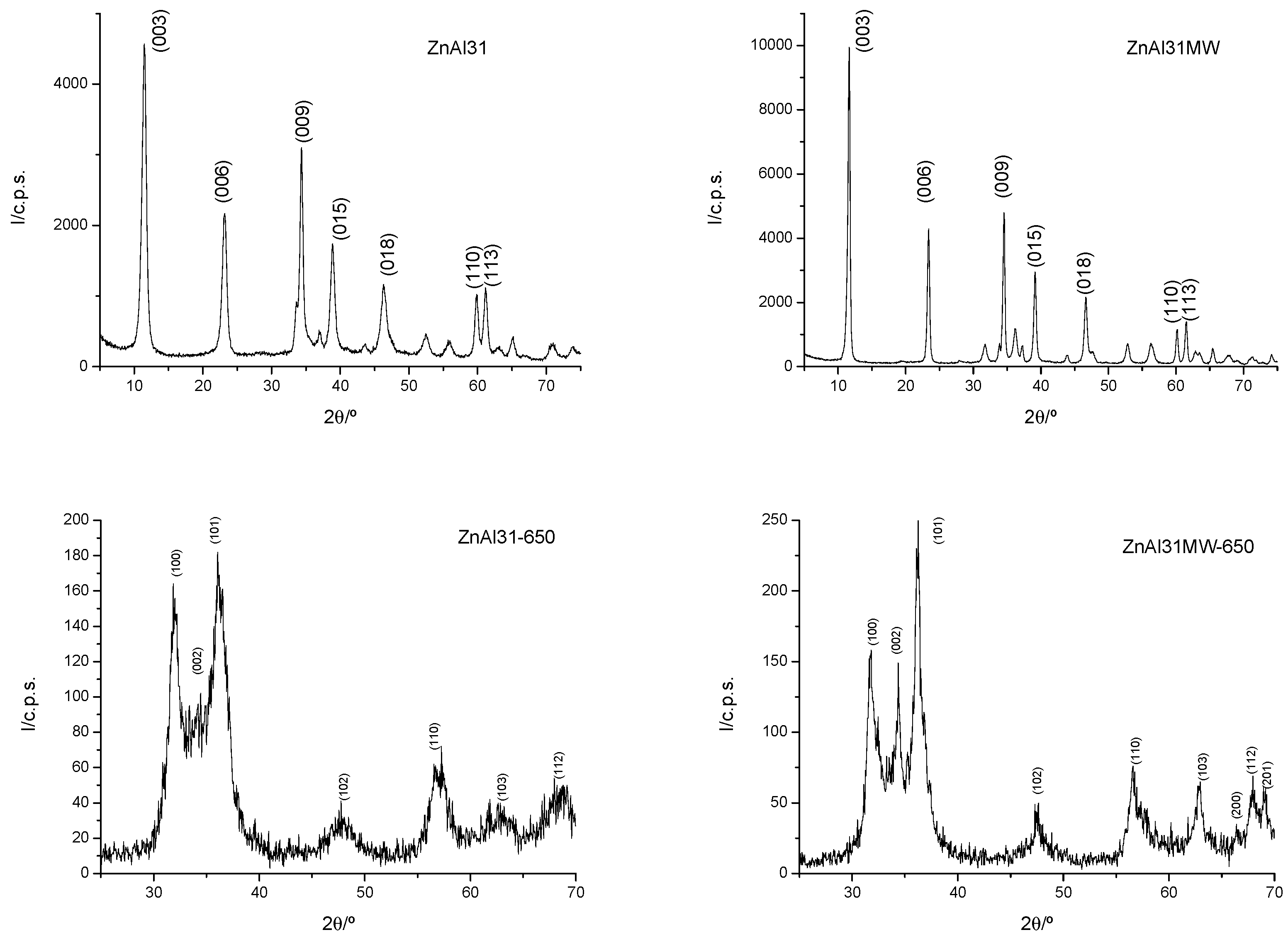
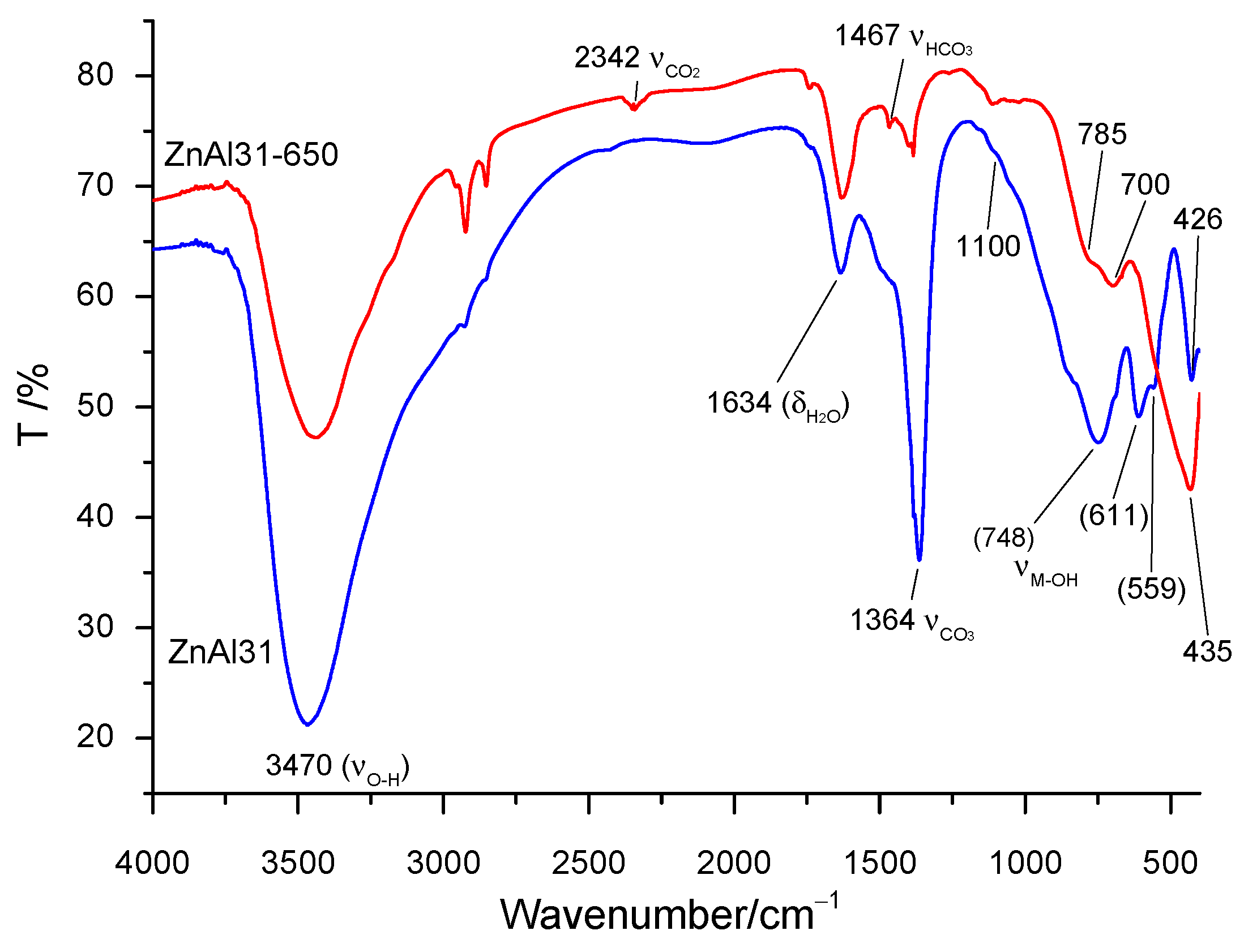

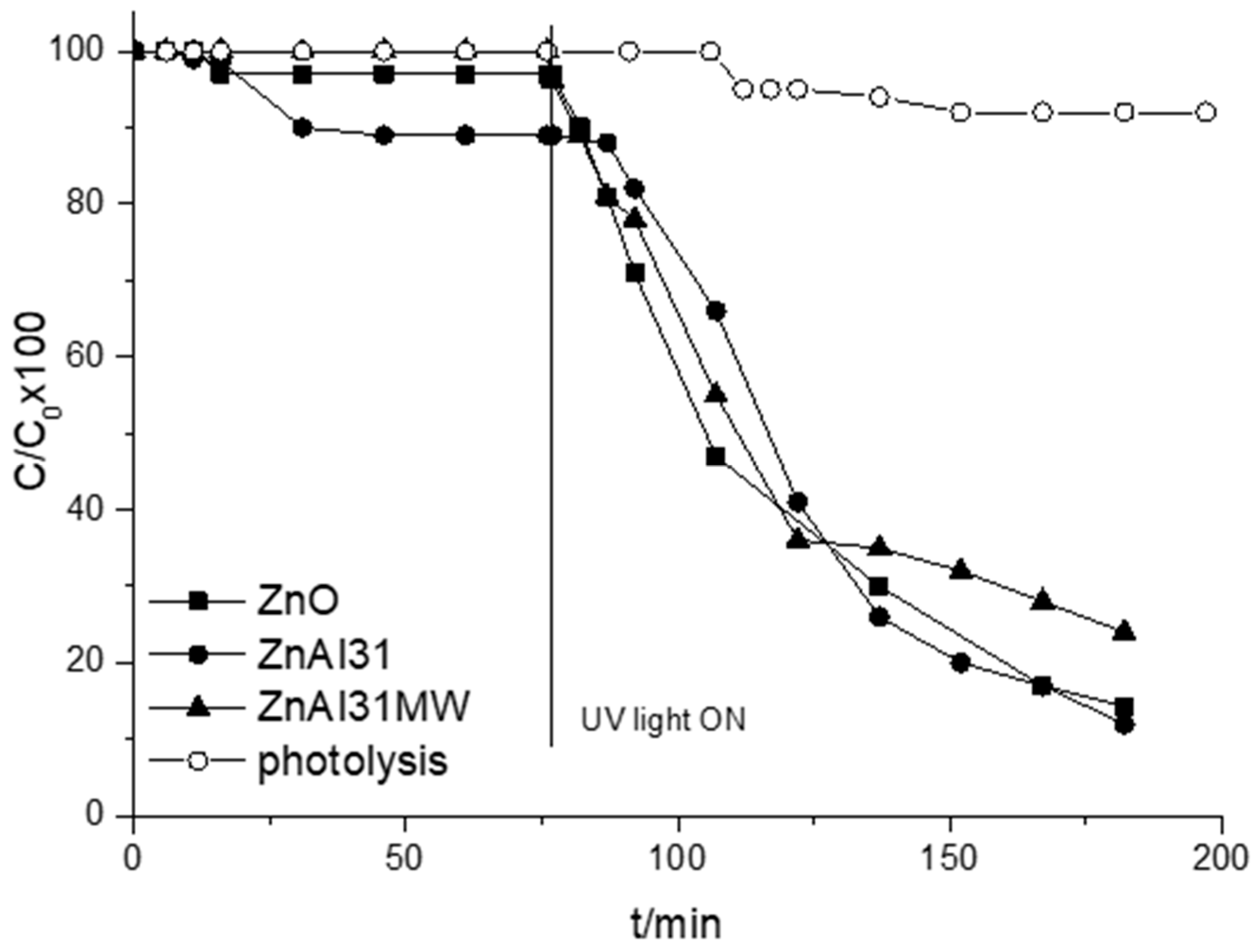
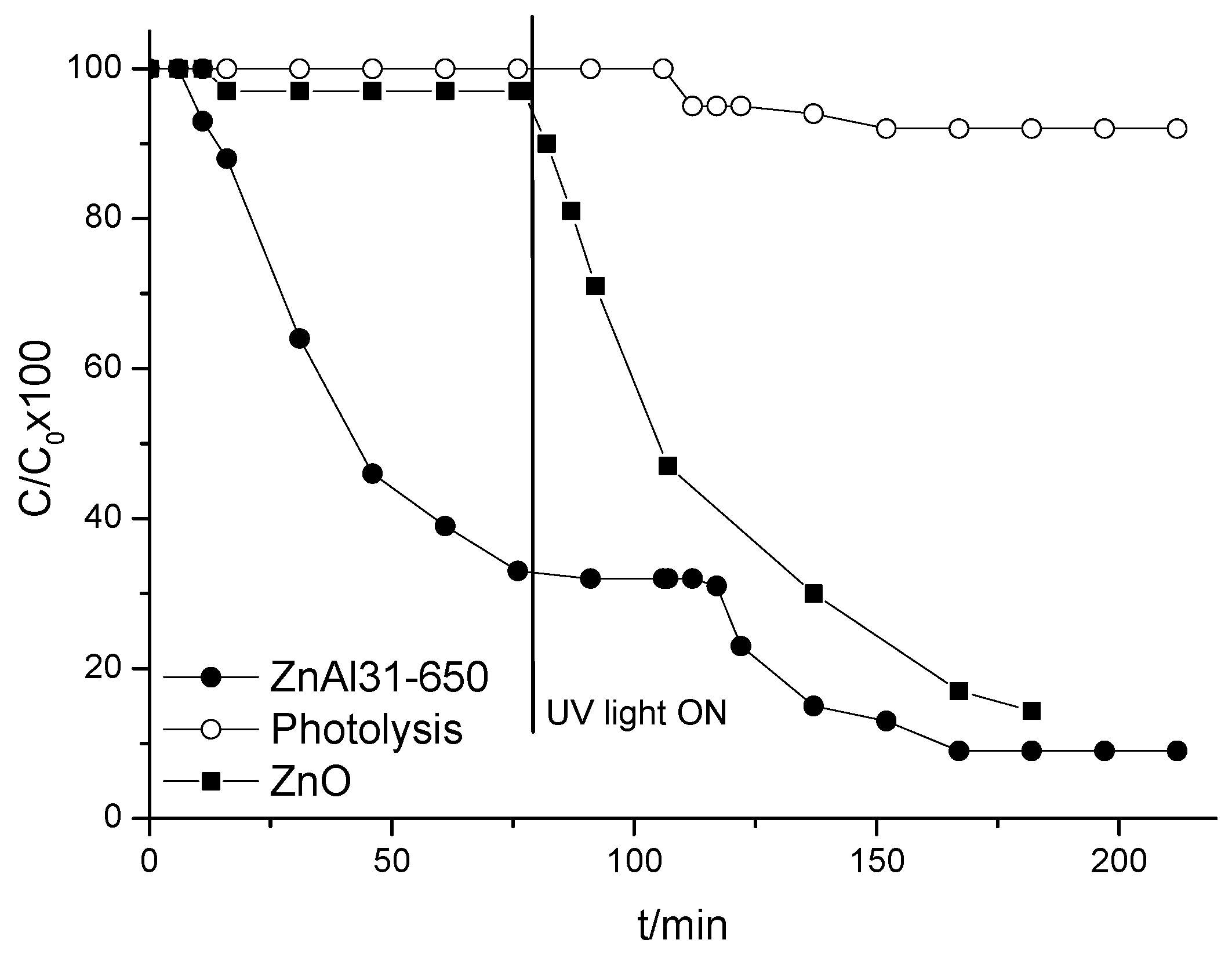
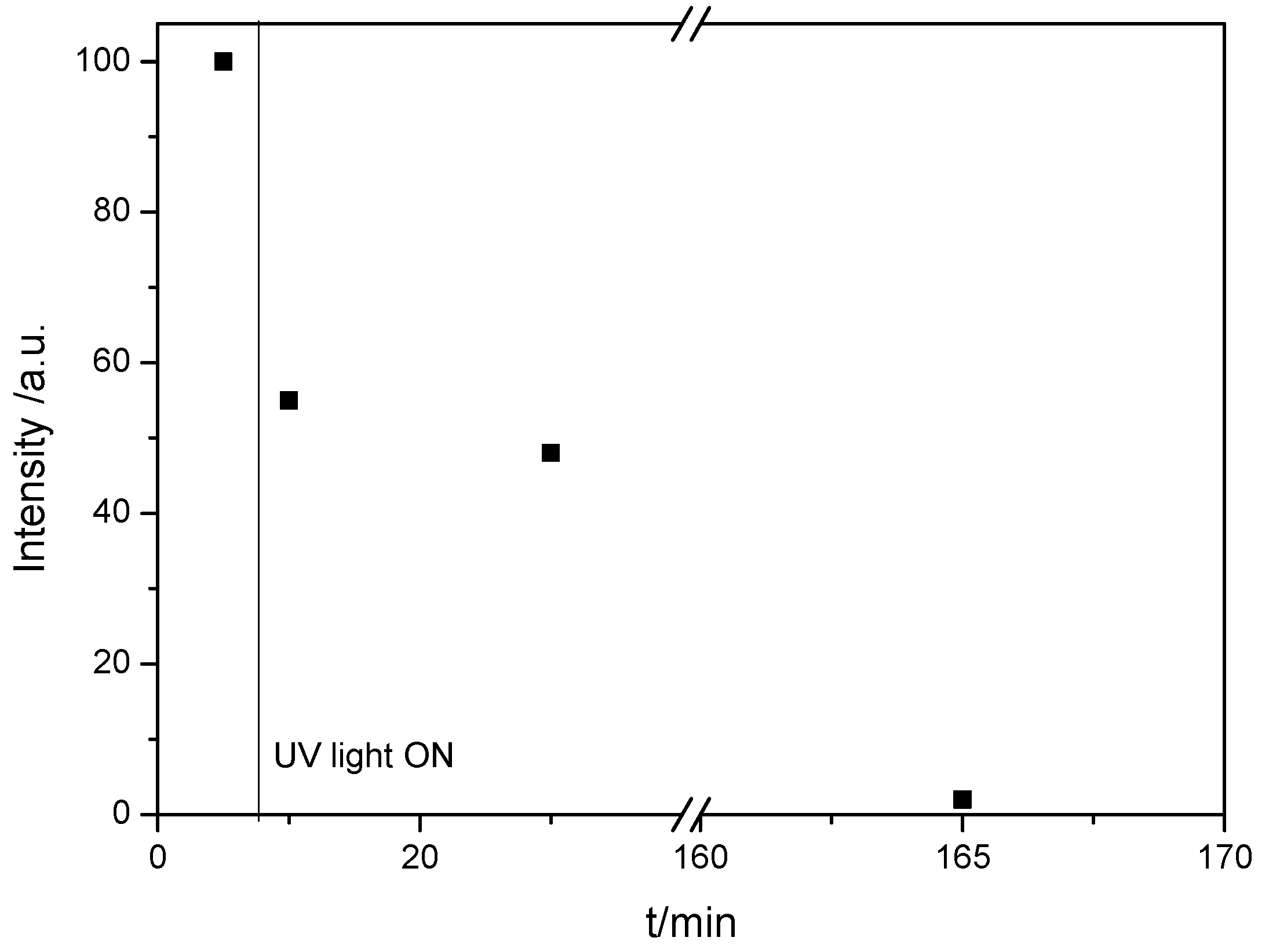
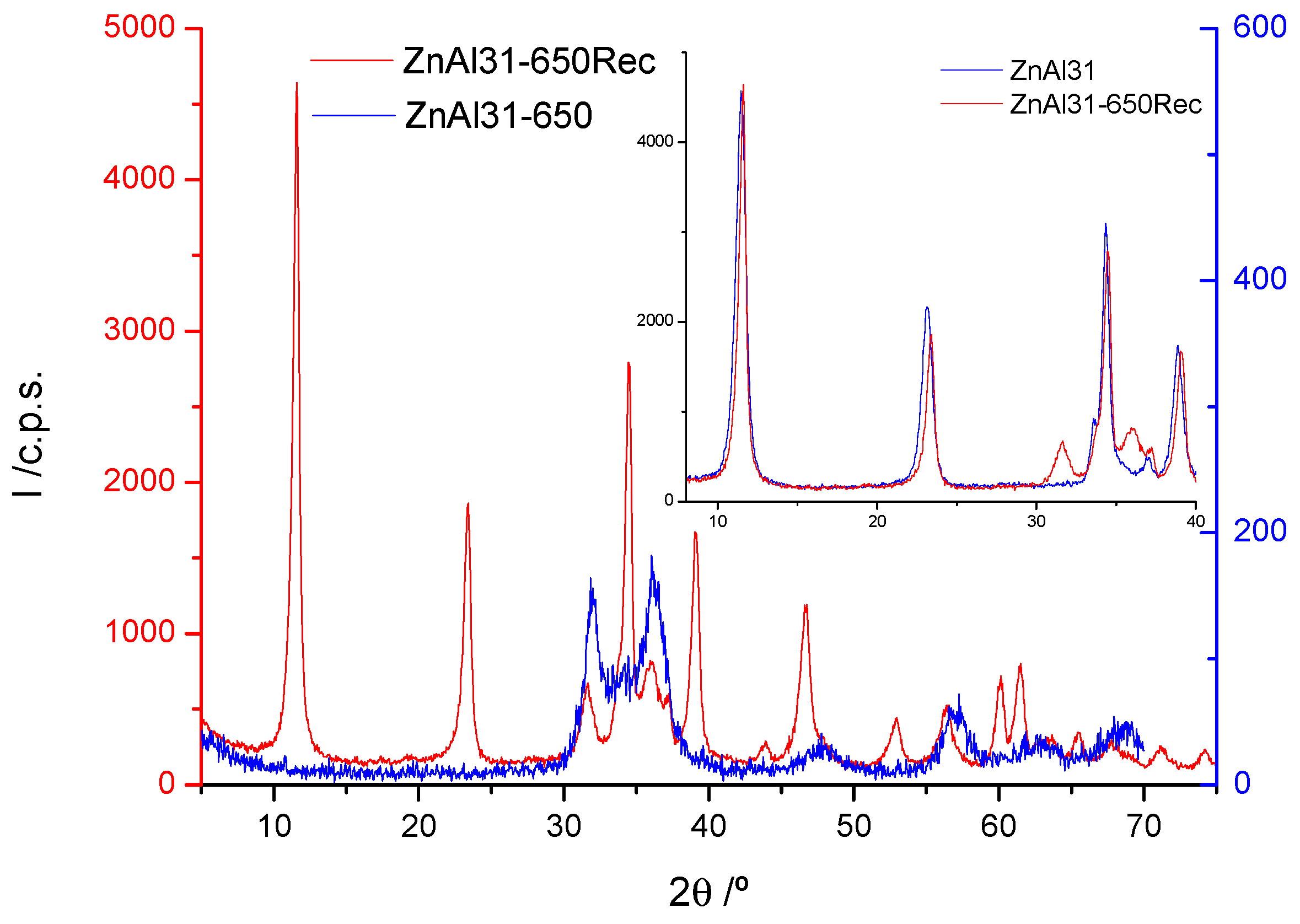
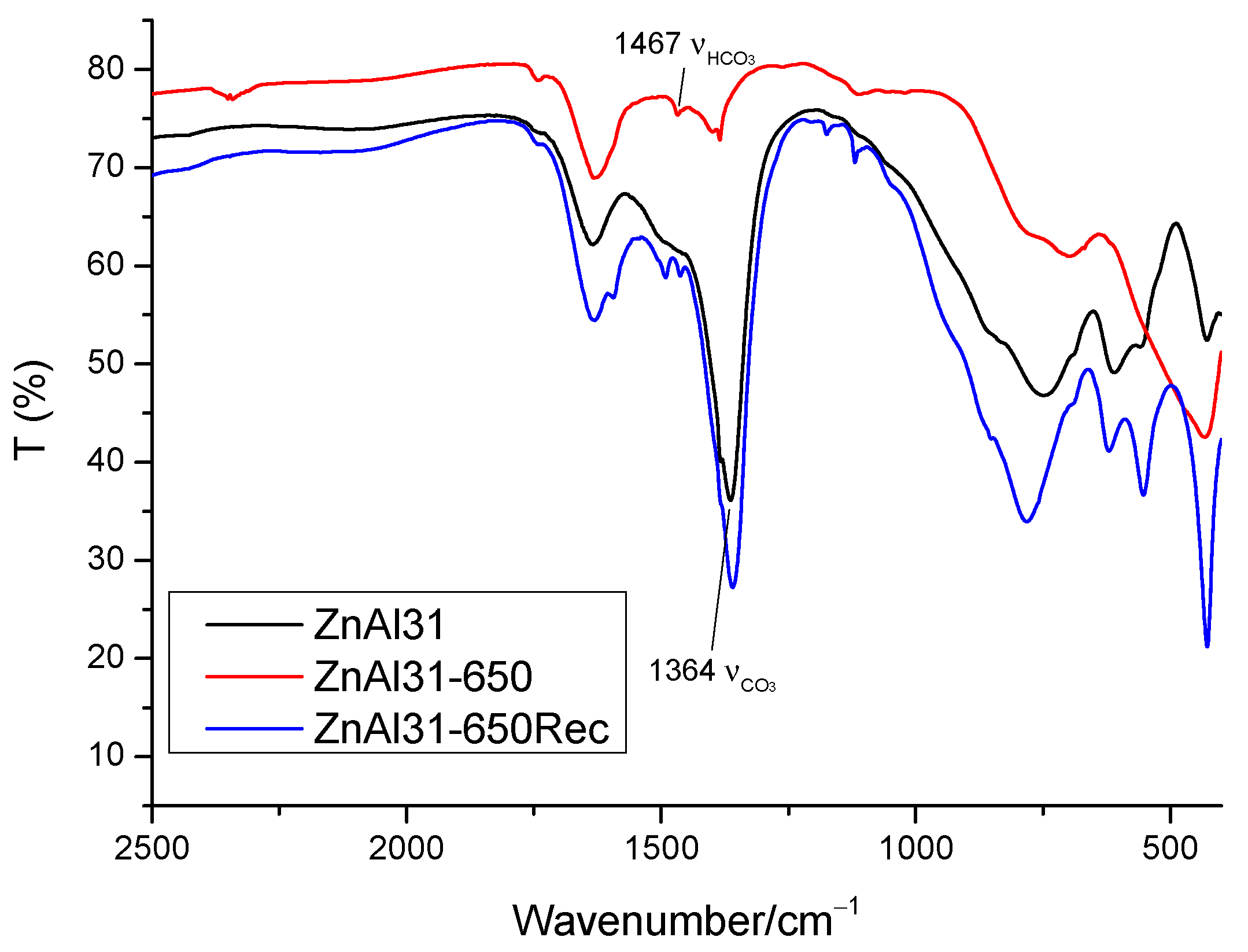
| Sample | c | a | β | D | ||
|---|---|---|---|---|---|---|
| (003) | (110) | (003) | (110) | |||
| ZnAl31 | 23.09 | 3.086 | 0.36 | 0.26 | 230 | 365 |
| ZnAl31MW | 22.85 | 3.074 | 0.17 | 0.19 | 480 | 510 |
| Sample | SBET | St | Smp |
|---|---|---|---|
| ZnAl31 | 51 | 51 | 0 |
| ZnAl31MW | 26 | 23 | 3 |
| ZnAl31-650 | 73 | 66 | 7 |
| ZnAl31MW-650 | 34 | 30 | 3 |
© 2020 by the authors. Licensee MDPI, Basel, Switzerland. This article is an open access article distributed under the terms and conditions of the Creative Commons Attribution (CC BY) license (http://creativecommons.org/licenses/by/4.0/).
Share and Cite
Trujillano, R.; Nájera, C.; Rives, V. Activity in the Photodegradation of 4-Nitrophenol of a Zn,Al Hydrotalcite-Like Solid and the Derived Alumina-Supported ZnO. Catalysts 2020, 10, 702. https://doi.org/10.3390/catal10060702
Trujillano R, Nájera C, Rives V. Activity in the Photodegradation of 4-Nitrophenol of a Zn,Al Hydrotalcite-Like Solid and the Derived Alumina-Supported ZnO. Catalysts. 2020; 10(6):702. https://doi.org/10.3390/catal10060702
Chicago/Turabian StyleTrujillano, Raquel, César Nájera, and Vicente Rives. 2020. "Activity in the Photodegradation of 4-Nitrophenol of a Zn,Al Hydrotalcite-Like Solid and the Derived Alumina-Supported ZnO" Catalysts 10, no. 6: 702. https://doi.org/10.3390/catal10060702
APA StyleTrujillano, R., Nájera, C., & Rives, V. (2020). Activity in the Photodegradation of 4-Nitrophenol of a Zn,Al Hydrotalcite-Like Solid and the Derived Alumina-Supported ZnO. Catalysts, 10(6), 702. https://doi.org/10.3390/catal10060702







